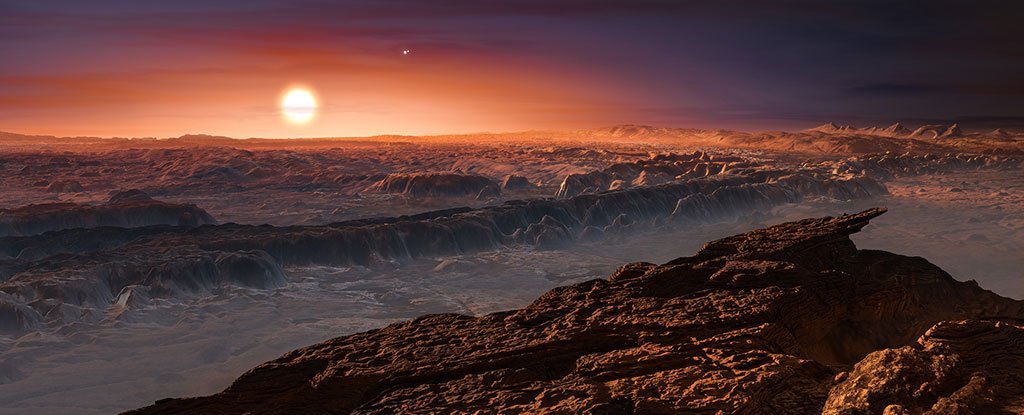Scientists say that Proxima b – the earth-like planet closest to our solar system – could still be inhabited, which gives us hope that literally under our side there can be a world that has conditions for maintaining the existence of extraterrestrial life.
The discovery of this planet caused a strong flurry of enthusiastic reviews in the scientific community and the media last year. Still, we have a new world before us, located in the inhabited zone of its star and besides quite close – only in some 4.2 light years. Shortly thereafter, the scientific community began to debate on the potential of its habitability. As with one, and on the other hand, quite logical arguments were given. And now, a new simulation shows that the planet is still able to provide support for a stable climate, potentially suitable for extraterrestrial life forms.
According to simulations created by researchers from Exeter University in the UK, Proxima b could have the conditions to support the liquid state of water on its surface with a number of different orbital characteristics and depending on how it turns around its star (scientists have not yet found it out ).
Briefly recall what is at issue:
Title: Proxima b.
Belonging: the planet of the Proxima Centauri system.
Distance to the object: 4.2 light years.
Special characteristics: the planet of the terrestrial group, closest to the solar system, is located in the habitable zone of its star.
The assumption that a planet can be unique in this system only increases its significance for scientists and researchers. Some of them are already even making ambitious plans to visit this potentially inhabited neighbor of the Earth. Unfortunately, now no one can accurately answer the question about whether there really is a life on Proxima b, so the only thing that remains for the scientist is to actually try to guess it based on the facts connected with its already known features, as well as the peculiarities of its Native system.
Previous attempts at analysis indicated that Proxima b can be covered with water, which would immediately increase the likelihood of life on it. Later, scientists have suggested that the planet can be a completely naked, out-of-the-way piece of stone, and this is due to the excessive activity of the star Proxima Centauri, in an unforgivable vicinity of which is “our” planet.
The level of hope “for a better future for humanity” reduced the reports of scientists published in February this year. Researchers from NASA then reported that stellar activity could burn out the atmosphere of Proxima b, leaving it completely oxygen-free (of course, if oxygen there was ever there at all).
However, a new study from Exeter University suggests that, with certain orbital characteristics, Proxima b could preserve the “habitable species and water-supporting atmosphere”.
Using the same modeling algorithms that are commonly used to simulate terrestrial meteorological conditions, the team found that Proxima b could maintain the presence of water on the surface, had it the same atmosphere as our Earth, or at least the atmosphere in which it was contained Nitrogen and carbon dioxide.
“Our model, unlike others, is able to take into account the variability of the level of emissions that the planet would have to experience in accordance with its orbital characteristics. We found that under certain conditions, Proxima b would be able not only to keep water in liquid form on its surface, but also to be habitable, “commented astrophysicist Nathan Mein.
There is an assumption that the exoplanet is in the tidal capture of its star. In other words, it is like the Moon, always directed by one side to the Earth. Simulations show that under such conditions it will also be able to maintain liquid water, albeit in a smaller volume, compared to if it could turn around itself during orbital rotation around the star.
Scientists also conducted their simulations taking into account the so-called orbital resonance with an exponent of 3: 2. That is, when the planet makes three complete turns around itself for two orbital turns around the star. Mercury, the first planet from the Sun, has the same orbital resonance, so scientists have suggested that if Proxima b has the same features, then the water on its surface in that case can be even greater. At the same time, the light and heat created by the star is enough to keep the temperature on the whole surface of the planet suitable for keeping water in a liquid form.
Of course, all this is still only hypothetical fabrications. But as long as we can not get close to Proxima b closer, this type of computer simulation remains our only source and food for assumptions related to the potential for its habitation. Moreover, at the moment, all the assumptions presented above are perhaps the most convincing arguments in favor of this potential so far.
“Of course, direct observations of the planet could provide us with much more information about the composition of its atmosphere, but now we do not have such an opportunity,” says Maine.
“Having learned more about the planet, we could exclude even more” free parameters “and eventually get a full picture of what Proxima b really is and what is its surface.”











